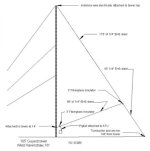Here's KPHX's new two tower site: https://licensing.fcc.gov/cdbs/CDBS...?appn=101800808&qnum=5150©num=1&exhcnum=2
The tall stick belongs to KSUN and radiates both 14~Hundred and 14~Eighty. The drop wire radiates 14~Eighty only. As more and more tower sites are being sold for the value of the land, Nurse Jeff and I think we'll be seeing more long wire antennas drop from the guy wires holding up a "real" tower. KPHX will be running with 950 watts day, and 320 watts night. Same pattern day & night.
The tall stick belongs to KSUN and radiates both 14~Hundred and 14~Eighty. The drop wire radiates 14~Eighty only. As more and more tower sites are being sold for the value of the land, Nurse Jeff and I think we'll be seeing more long wire antennas drop from the guy wires holding up a "real" tower. KPHX will be running with 950 watts day, and 320 watts night. Same pattern day & night.


